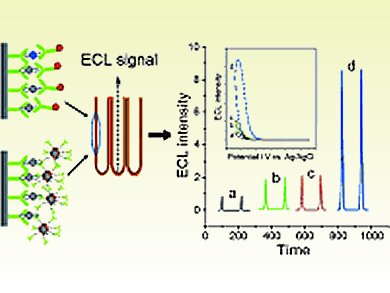Immunoassays represent an important quantitative technique and are applied in many fields such as environmental monitoring, food safety, and clinical diagnosis. In general, whereas highly specific antigen/antibody recognition usually ensures the specificity of the assay, the sensitivity is ultimately enhanced by increasing the amount of captured label per binding event.
Patrik Schmuki, University of Erlangen-Nuremberg, Germany, Yan-Yan Song, Northeastern University, Shenyang, China, and co-workers apply an electrochemiluminescent (ECL) technique and show that TiO2 nanotube (TiNT) layers have advantageous properties over conventional 3D nanostructured electrodes. Further, they use TiO2 nanoparticles to achieve multiple quantum dot (QD) responses from a single recognition event. The antibody-modified TiNT layers bind the antigens, which then are bound by an immunosensing probe in a sandwich-type immunoassay. The sensing probe consists of an antibody-modified QDs/TiNP hybrid, which in the event of binding leads to a measurable ECL signal at low-level antigen concentrations.
Signal Amplification Strategy Based on TiO2-Nanotube Layers and Nanobeads Carrying Quantum Dots for Electrochemiluminescent Immunosensors,
Zhi-Da Gao, Qian-Lan Zhuang, Yan-Yan Song, Kiyoung Lee, Patrik Schmuki,
ChemistryOpen 2013.
DOI: 10.1002/open.201300003



